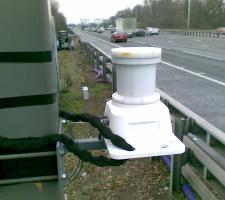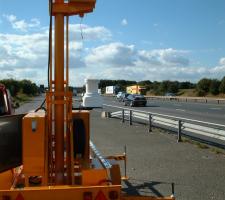
Navtech Radar's millimetric-wave systems are being researched on the M42 in England to look into how this type of detector can assist in the opening of the hard shoulder as an additional running lane. Here, the company's Stephen Clark talks about the technology being used.
In England, theThe more efficient use of existing infrastructure holds the promise of being significantly less expensive than adding new roads or lanes. Such initiatives are also more attractive from a planning perspective, being simpler and quicker to implement. However, safety cannot be compromised and any decision on whether to open hard shoulders to running traffic must be taken in the secure knowledge that they are clear of stopped vehicles or debris. At present, the operational solution, for example on the M42, uses fixed cameras which are placed every 100-200m along the route to feed screens watched by HA Traffic Officer.
Radar, however, appears to hold promise when it comes to automating the detection process and systems developed and manufactured by Wantage (Oxford, UK)-based
Trial installations
The first proof of concept, using a single gantry-mounted system to detect vehicles on the hard shoulder, took place in 2007. However, according to Navtech's co-founder Stephen Clark, radar really made its presence felt as a part of the HArd Shoulder MOnitoring System (HASMOS) project, developed by SEA and run by WSP on behalf of the HA. The HASMOS proof-of-concept data fusion tool has the potential to pull together inputs from multiple detector types (loops in the road, CCTV cameras and more latterly radar) and includes algorithms able to provide an optimum answer from the information gathered.A follow-on trial on the M42 involved a three-radar system for detecting incidents across all lanes and, more recently, a five-radar system mounted typically 2m above the ground on existing adjacent gantries for the purpose of incident detection on the hard shoulder (mounting heights are chosen in each case for optimum coverage in terms of fields of view). The five radars in the latter test provided a total of around 3.5km of overlapping coverage, says Clark.
"Alarms were generated based on speeds falling below pre-determined thresholds. For the hard shoulder monitoring application HASMOS did not need speed, track identity and positional information for all vehicles, so we send on only the track information likely to indicate a problem or something on the hard shoulder, together with confidence limits. This allowed the system to make judgements and alarms to be generated as appropriate. We also generated our own alarms independently from HASMOS for comparison. Video footage was used by WSP Group as a truth model against which to check alarm logs and we were able to demonstrate a high detection rate for those areas within radar coverage whilst retaining a very low false alarm rate. Effectively, we've proved that this equipment could be used as a future operator support tool for a wider hard shoulder management deployment."
Niche competency
The HASMOS research trial has been a success and has enabled the HA to prove the concept. Although the project was only interested in the detection of stopped vehicles on the hard shoulder, Clark says the radar has other possible applications too. For example, radar could be used to give similar information at multiple loops sites and it can also be used to detect incidents across multiple lanes from the roadside. Given that information is gathered on speed and position, accurate queue detection is another possibility. He therefore sees Navtech's products as filling a particular niche."Our systems can also complement loops, CCTV and support decisions made by Traffic Officers. Loops are great for telling you what's on top of them but not for telling you what's going on between. Radar isn't a loop substitute unless you're looking to replace a whole series of them - although that is an option. It also has advantages over CCTV in certain weather and light conditions.
"There are solutions which are positioned as direct loop competitors - side-fired radars and buried magnetometers, for instance. Our solution scans a whole area 360o in azimuth to give that capability." Navtech offers a range of communication and power options. Cat 5/Ethernet and fibre optics can be used for longer data transmission distances but wireless capabilities are available - as are solar and wind power, which opens up the possibility of portable applications.
The company's radar systems have been deployed to cover an area and control up to five CCTV cameras, per radar. Multiple radar systems can be networked. Areas of interest are zoned out using software and the system provides an early warning capability which focuses operator attention.
Applications such as work zone safety have been considered but they demonstrate the need to find partners with the appropriate technology integration expertise, according to Clark.
Navtech Radar
Navtech's first clients were end-users in mining and stevedoring using vehicle automation programmes which relied on robot sensing technology. The company has since diversified into the security, airport surface movement and road monitoring sectors. It offers a series of products working at 77GHz which, depending on model, can detect a person-sized object at up to 800m with 25cm resolution.
The company's two principle products for the road monitoring sector are the TS500 and the TS350-X.
The TS500 can detect a man-sized object within a radius of 500m (1,000m diameter), and a vehicle within a radius of 800m. It is suitable for mounting within a few metres of the road surface or at ground level. Higher mounting positions are feasible but consideration must be given to detection beneath the sensor mount.
The TS350-X can detect a man-sized object within a radius of 350m and a vehicle within a radius of 500m. It is suitable for mounting close to the road or on an elevated mounting and includes enhanced detection coverage.
Although vehicles and vehicle incidents can be detected to 800m, dependent on the sensor used, accurate determination of the lane in which an incident has occurred is only possible out to a radius of 300-400m."Some installations have used 3G communications and we've talked about using radar at the beginning of contraflow schemes to alert operatives working downstream. We need an integrator, though; we're an applied technology organisation but we're also very much a technology provider. We wouldn't go out and outfit a large fleet of vehicles with our systems, for example." The company's systems work at 77GHz. Where radar systems are concerned, the higher the frequency, the smaller the sensor required. This results in a compact system. A narrower beam also allows lane definition out to 300-400m in either direction (that is, out to a diameter of up to 800m - Clark describes attenuation at those sorts of distances as "minimal"). There are both advantages and disadvantages to the frequency choice, however. Although the frequency is fine for operations in Europe, in the US
Next steps
Technological next steps include improving the detection area of individual systems and allowing for more flexible deployment options along the roadside. Beam divergence means that vehicle detection becomes more of a challenge as distance increases however Clark notes that some users have stringent requirements on minimum rather than maximum ranges. Navtech's current systems have a minimum range of 10m in either direction from the radar scanner (or a total blind spot diameter of 20m) but Clark says that tests have indicated that this can probably be reduced to 2m in any one direction (or a diameter of 4m). With the system typically mounted 1m back from the roadside, that would mean complete coverage up to 800m from a single radar system, he says. In any case, multiple radar systems can be sited such that their detection zones overlap and work in unison.Tunnels are another application area with potential. The contrast between light and dark conditions can be challenging for CCTV systems and can lead to higher than acceptable false alarm rates. Navtech radar systems have been deployed in tunnels in the UK and are performing well, detecting approaching and receding traffic at distances out to 500m, according to Clark.













